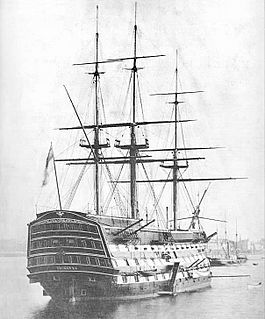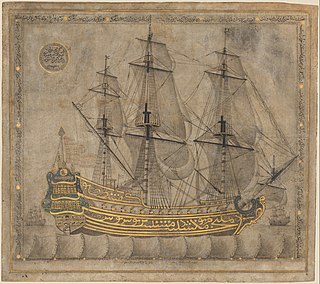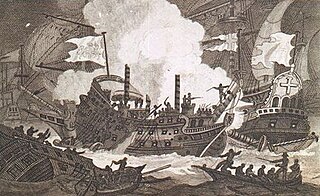
A ship of the line was a type of naval warship constructed during the Age of Sail from the 17th century to the mid-19th century. The ship of the line was designed for the naval tactic known as the line of battle, which depended on the two columns of opposing warships maneuvering to volley fire with the cannons along their broadsides. In conflicts where opposing ships were both able to fire from their broadsides, the opponent with more cannons firing – and therefore more firepower – typically had an advantage. Since these engagements were almost invariably won by the heaviest ships carrying more of the most powerful guns, the natural progression was to build sailing vessels that were the largest and most powerful of their time.

Galleons were large, multi-decked sailing ships first used as armed cargo carriers by European states from the 16th to 18th centuries during the age of sail and were the principal vessels drafted for use as warships until the Anglo-Dutch Wars of the mid-1600s. Galleons generally carried three or more masts with a lateen fore-and-aft rig on the rear masts, were carvel built with a prominent squared off raised stern, and used square-rigged sail plans on their fore-mast and main-masts.

In the rating system of the British Royal Navy used to categorise sailing warships, a first rate was the designation for the largest ships of the line. Originating in the Jacobean era with the designation of Ships Royal capable of carrying at least 400 men, the size and establishment of first-rates evolved over the following 250 years to eventually denote ships of the line carrying at least 80 guns across three gundecks. By the end of the eighteenth century, a first-rate carried no fewer than 100 guns and more than 850 crew, and had a measurement (burthen) tonnage of some 2,000 tons.

A warship or combatant ship is a naval ship that is built and primarily intended for naval warfare. Usually they belong to the armed forces of a state. As well as being armed, warships are designed to withstand damage and are usually faster and more maneuverable than merchant ships. Unlike a merchant ship, which carries cargo, a warship typically carries only weapons, ammunition and supplies for its crew. Warships usually belong to a navy, though they have also been operated by individuals, cooperatives and corporations.

The Battle of Oliwa, also known as the Battle of Oliva or the Battle of Gdańsk Roadstead, was a naval battle that took place on 28 November, 1627, slightly north of the port of Danzig off of the coast of the village of Oliva during the Polish–Swedish War. It was the largest naval engagement to be fought by the Polish–Lithuanian Commonwealth Navy and resulted in defeating a Swedish squadron led by Niels Stiernsköld that conducted a blockade of the harbour of Danzig. The Poles sailed out of the Danzig harbour and engaged the Swedish squadron capturing the Swedish flagship and sinking another Swedish warship.

São Vicente is a coastal municipality at southern São Paulo, Brazil. It is part of the Metropolitan Region of Baixada Santista. The population is 368,355 in an area of 147.89 square kilometres.

The naval Battle of Gibraltar took place on 25 April 1607, during the Eighty Years' War, when a Dutch fleet surprised and engaged a Spanish fleet anchored at the Bay of Gibraltar. During the four hours of action, most of the Spanish ships were destroyed.
Diego Fajardo Chacón was a Spanish military officer and governor of the Philippines, from August 11, 1644 to July 25, 1653.

The minion was a type of small cannon used during the Tudor period and into the late 17th century. It was of a small bore, typically 3-inch (76.2mm), and fired a 5-pound cannonball.

The Battles of La Naval de Manila were a series of five naval battles fought in the waters of the Spanish East Indies in the year 1646, in which the forces of the Spanish Empire repelled various attempts by forces of the Dutch Republic to invade Manila, during the Eighty Years' War. The Spanish forces, which included many native volunteers, consisted of two, and later, three Manila galleons, a galley and four brigantines. They neutralized a Dutch fleet of nineteen warships, divided into three separate squadrons. Heavy damage was inflicted upon the Dutch squadrons by the Spanish forces, forcing the Dutch to abandon their invasion of the Philippines.

The São João Baptista, commonly known as the Botafogo, was a Portuguese galleon built in the 16th century, around 1530, considered the biggest and most powerful warship in the world by Portuguese, Castillian and Italian observers of the time.

The Battle of Gibraltar took place on 10 August 1621, during the Eighty Years' War between the Spanish Empire and the Dutch Republic. A Dutch East India Company fleet, escorted by a squadron under Willem Haultain de Zoete, was intercepted and defeated by nine ships of Spain's Atlantic fleet under Fadrique de Toledo while passing the Strait of Gibraltar.

The Battle of Santa Cruz de Tenerife was a military operation in the Anglo-Spanish War (1654–60) which took place on 20 April 1657. An English fleet under Admiral Robert Blake penetrated the heavily defended harbour at Santa Cruz de Tenerife in the Spanish Canary Islands and attacked their treasure fleet. The treasure had already been landed and was safe but the English engaged the harbour forts and the Spanish ships, many of which were scuttled and the remainder burnt. Having achieved his aim, Blake withdrew without losing any ships.

The action of 18 February 1639 was a naval battle of the Eighty Years' War fought off Dunkirk between a Dutch fleet under the command of Admiral Maarten Tromp and the Spanish Dunkirk Squadron under Miguel de Horna. Horna, who had orders to join with his ships Admiral Antonio de Oquendo's fleet at A Coruña, escorted at the same time a transport convoy carrying 2,000 Walloon soldiers to Spain, where they were needed. The attempt to exit Dunkirk was done in sight of the Dutch blockading squadron of Maarten Tromp. A 4-hour battle ensued and Horna was forced to retreat into Dunkirk leaving behind two of his galleons, whilst another ran aground. Despite his success in stopping the sortie, many of Tromp's ships suffered heavy damage, and the Dutch Admiral was forced to abandon the blockade. Therefore, De Horna, after repairing his squadron, was able to accomplish his mission.
The Capture of the galleon San Joaquin or the Battle of Cartagena was a naval engagement that took place off the coast near Cartagena. It involved five British ships of the line against the Spanish galleon San Joaquin and a smaller ship. After an action lasting barely an hour the Spanish ship surrendered. The galleon had fought in the previous encounter during Wager's Action nearly three years earlier but had just barely escaped capture.

The Battle of the Gulf of Cádiz was a naval action which occurred on 7 August 1604, during the last days of the Anglo-Spanish War (1585–1604). The battle took place when a flotilla of two galleons commanded by Antonio de Oquendo engaged two English privateers who were plundering shipping lanes and villages around the Gulf of Cádiz. One of the English ships was captured and the other damaged. Oquendo's action off Cádiz is notable for having been fought just 21 days before the signing of the Treaty of London, which ended the protracted war between England and Spain.

The square-rigged caravel, was a sailing ship created by the Portuguese in the second half of the fifteenth century. A much larger version of the caravel, its use was most notorious beginning in the end of that century. The square-rigged caravel held a notable role in the Portuguese expansion during the age of discovery, especially in the first half of the sixteenth century, for its exceptional maneuverability and combat capabilities. This ship was also sometimes adopted by other European powers. The hull was galleon-shaped, and some experts consider this vessel a forerunner of the fighting galleon, by the name of caravela de armada.

The Calligraphic Galleon is an example of Islamic calligraphy dating to the mid-18th century. Attributed to a calligrapher in the Ottoman Empire, the work depicts a galleon of the Ottoman navy. The ship is inscribed with the names of the Seven Sleepers, a group of men who were protected by the Abrahamic God, likely to confer a blessing of protection on the ship. It is in the collection of the Metropolitan Museum of Art.

The race-built galleon was a type of war ship built in England from 1570 until about 1590.
















